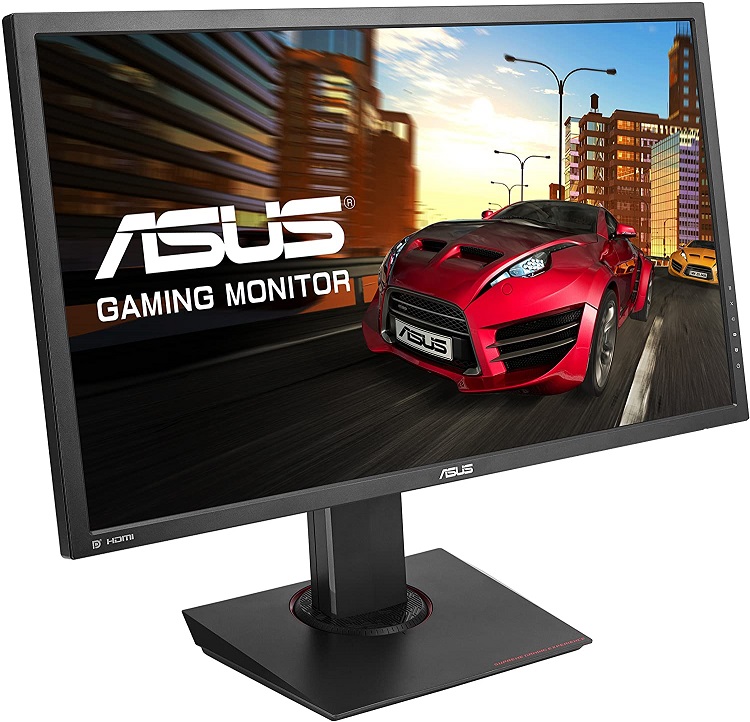What Are Vertical Monitors?
Vertical monitors are computer monitors that have a much longer height than width. Regular (also known as horizontal) monitors, on the other hand, have the exact opposite dimensions – they are wider and shorter in height. A vertical monitor is the same shape as portrait photography and the horizontal monitor would fit better landscape photography. Vertical monitors are especially popular among programmers.
Why Use a Vertical Monitor?
There are many reasons why an increasing number of people use vertical monitors instead of regular horizontal ones. Here are just a few of them:
Better for Text
Vertical monitors are known for their increased ability to display text. While a horizontal monitor tends to show a lot of the annoying ‘whitespace’ on the sides of the text, which is usually located in the middle of the screen, a vertical monitor is too narrow to display anything other than the text itself. Thus, a vertical monitor is way more convenient for reading and writing.
Less Space
One of the biggest advantages of vertical monitors is that they take up much less space than horizontal monitors. A dual vertical monitor will show you the same amount of content as two horizontal monitors while taking up less than half as much space on your desk.
Affordability
While vertical monitors are less common and thus tend to be more expensive than the regular ones (especially if they have the ability to switch between landscape and portrait mode), in times of low demand, they can actually be much cheaper than the standard ones.
Improved Peripheral Vision
When you have extra-wide monitors or multiple horizontal monitors you lose your peripheral vision. With vertical monitors, you won’t experience that problem.
Perfect for Coding
Vertical monitors allow you to see more lines of codes at the same time. As such, they are great for coding.
Easier on the Eyes
Another great benefit of using vertical monitors is that they tend to reduce eye strain and thus decrease the risk of getting computer vision syndrome (CVS).For Eye strain monitor visit Computer Monitor for Eyes
Fewer Head Movements
For a complete view of your standard horizontal monitors, you have to turn your head, especially if you use multiple monitors. Vertical monitors, on the other hand, allow you to see everything by only moving your eyes.
The 10 best vertical monitors – reviews
Here’s a list of the top 10 best vertical monitors currently available. Check out their pros and cons and why we think they would be a great fit for you.
ASUS Vertical Monitor VN279QL 27” Full HD 1920×1080
The ASUS Vertical Monitor VN279QL is one of the best vertical monitors out there. It is a 27-inch VA panel LED monitor with a maximum resolution of 1920 by 1080 and an aspect ratio of 16:9. It can rotate and operate in landscape position as well as in portrait mode. Therefore it is multifunctional and incredibly useful for all kinds of work. Its refresh rate is 60 Hz, which may not be great for highly competitive gamer. On the other hand, it has a response time of 4 milliseconds, which is quite good for gaming. It doesn’t support any kind of syncing technology. It comes with built-in speakers. Its bezel thickness is 8 millimeters, which is quite narrow and a great choice for a multiple screen setup. In addition, it is VESA mount compatible, which further simplifies adding it to a multiple screen setup. The monitor also offers a height adjustment option and a stand that can tilt and swivel.

 Ergonomic
Ergonomic Built-in speakers
Built-in speakers Versatile
Versatile VESA compatible
VESA compatible Pivot capability
Pivot capability
 No syncing technology
No syncing technology Poor quality control
Poor quality control
The reason we recommend this vertical monitor to you:
This is an incredibly useful monitor that can serve a wide variety of purposes. It is a great choice, especially for coders, programmers, and other people who work with text. It is also a decent choice for gamer, even though professional gamer may need a higher refresh rate and a faster response time.
Dell U2414H 23.8” Widescreen Vertical Monitor
This 23.8-inch IPS panel LED vertical monitor is another great option. It has a maximum resolution of 1920 by 1080 and an aspect ratio of 16:9. Like the previous monitor, this one also has full pivot capability and the ability to operate in landscape position as well as portrait mode. With its slow response time of 8 milliseconds and a low refresh rate of 60 Hz, it is not a very good option for gamer. On the bright side, it is very energy efficient – it’s EPEAT Gold certified, TCO Certified, and meets the ENERGY STAR regulation. It features an MHL port for easy connection to smartphones and tablets. It is also VESA mount compatible and thus great for a multiple screen setup.
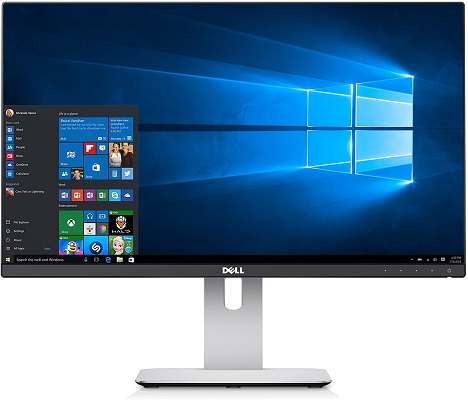
 Energy efficient
Energy efficient VESA compatible
VESA compatible MHL compatible
MHL compatible Pivot capability
Pivot capability
 Not very robust
Not very robust Not great for gaming
Not great for gaming
The reason we recommend this vertical monitor to you:
This monitor is a great option for a large variety of purposes, including programming, coding, writing, reading, photography, and video editing.
ViewSonic XG2560 25” 1080p 240Hz 1ms Gsync Vertical Monitor
Some consider this 25-inch LCD monitor with a Full HD 1090p resolution the best monitor for gaming. Considering the fact that it has the fastest frame rate possible (240 Hz) and a super brief response time of 1 millisecond, it is indeed every professional gamer’s dream come true. It comes with Nvidia G-Sync, which provides additional speed and smoothness to the users who have an Nvidia GPU. The LCD display offers numerous image quality improving features, such as Black Stabilization technology and Ultra Low Motion Blue technology.
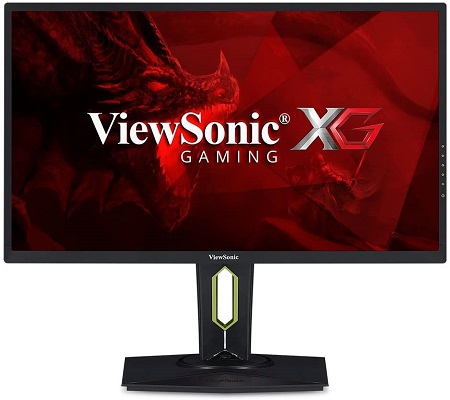
 240 Hz refresh rate
240 Hz refresh rate 1 ms response time
1 ms response time Nvidia G-Sync
Nvidia G-Sync Reasonable price
Reasonable price
 Not a very wide viewing angle
Not a very wide viewing angle
The reason we recommend this vertical monitor to you:
If you are a highly competitive gamer, this monitor might be the best choice for you, as it is extremely fast and it offers various game modes. However, as it offers a great image quality (despite being and LCD monitor), it is suitable for a wide range of purposes. Moreover, it is slightly less expensive than the competition.
HP VH240a 23.8” Full HD 1080p Rotating Portrait & Landscape, Tilt
This 23.8-inch LED monitor with an IPS panel type has a maximum resolution of 1920 by 1080 and a 16:9 aspect ratio. It has full pivot capability and it operates both in landscape and portrait mode. It’s also capable of tilting and offers an adjustable height. It has a refresh rate of 60 Hz and a response time of 5 milliseconds and therefore it’s not a great option for serious gamer. It has built-in speakers and it’s VESA compatible, which makes the monitor a good choice for a multiple screen setup.
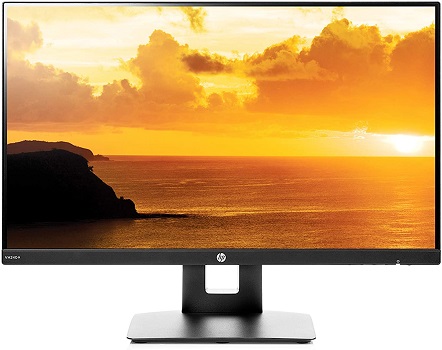
 Ergonomic
Ergonomic Pivot capability
Pivot capability Built-in speakers
Built-in speakers VESA compatible
VESA compatible
 Low brightness
Low brightness
The reason we recommend this vertical monitor to you:
If you are a fan of HP technology, this may be the right vertical monitor for you. It is very ergonomic, adjustable, and user-friendly and in case you have no other audio options, this monitor offers the convenience of built-in speakers.
Dell UltraSharp U2515H 25” Screen LED-Lit Monitor
The 25-inch LED vertical monitor from Dell is considered the best 2K vertical monitor on the market. It has a QHD 2560 by 1440 maximum resolution. The image quality is exceptional. It offers deep darks, a 99-percent sRGB color accuracy, and a wide range of colors. It is multi-functional yet extremely convenient and simple to use. For example, it has a thin bezel and a firmware that simplifies adding it to a multiple screen setup. Moreover, the monitor is enhanced with an ultra-wide viewing angle of 178-degrees from all directions. It has a refresh rate of 60 Hz and a response time of 6ms in fast mode and 8ms in normal mode, which makes it less than ideal for gamer.
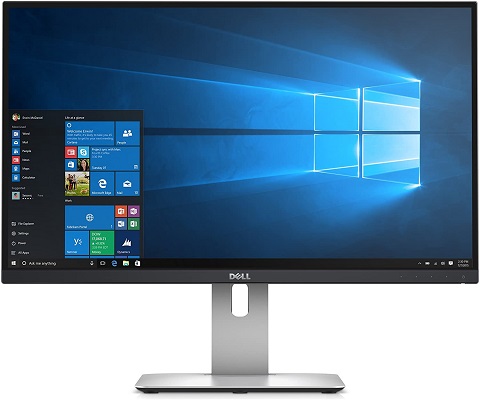
 2K resolution
2K resolution 178-degree viewing angle
178-degree viewing angle 99-percent color accuracy
99-percent color accuracy Eco-certifications
Eco-certifications
 Not very robust
Not very robust
The reason we recommend this vertical monitor to you:
The 2K resolution makes the Dell UltraSharp U2515H ideal for most situations. The monitor is user-friendly and it offers great image quality.
ASUS MG28UQ 4K/UHD 28” FreeSync Gaming Vertical Monitor
This 28-inch with a TN panel, an amazing maximum resolution of 3840×2160 Pixels, and a response time of 1 millisecond is a great option for gamer, even with a less than ideal refresh rate of 60 Hz. It even comes with gaming features such as GamePlus and GameVisual. It has a very ergonomically-designed stand with tilt, swivel, full pivot, height adjustment, and wall-mount capability. It features advanced eye care technology with TUV certified flicker-free and blue light filters for less eye strain.
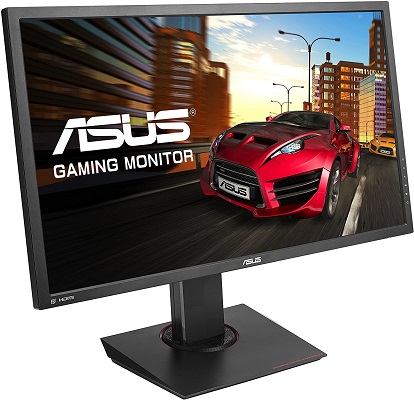
 4K resolution
4K resolution ASUS Eye care technology
ASUS Eye care technology 1 ms response time
1 ms response time AMD FreeSync Adaptive-Sync technology
AMD FreeSync Adaptive-Sync technology Ergonomic
Ergonomic
 Poor firmware
Poor firmware Questionable durability
Questionable durability
The reason we recommend this vertical monitor to you:
The MG28UQ 4K monitor from Asus is one of the best monitors for gaming. One of its most notable advantages is its exceptionally high resolution. Overall, it is probably the best 4K vertical monitor on the market.
Acer SB220Q Vertical Monitor
The 21.5-inch ultra-thin zero frame IPS monitor with a maximum resolution of 1920 x 1080 is also one of the best vertical monitors currently on the market. It has a 75 Hz refresh rate, a 4 milliseconds response rate, and an AMD Radeon FreeSync Technology which makes it a good choice for a smooth gaming experience. The advanced liquid crystal formula for the IPS technology enables a wide viewing angle and great color performance and the frameless design allows maximum visibility. The monitor with a stylish and modern construction is very thin and portable and thus easy to store.
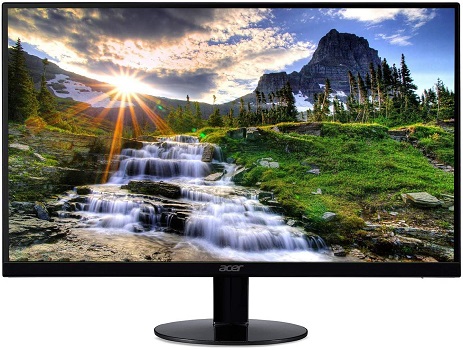
 AMD Radeon FreeSync Technology
AMD Radeon FreeSync Technology Advanced IPS technology
Advanced IPS technology Wide viewing angle and great color performance
Wide viewing angle and great color performance Thin frameless design
Thin frameless design
 Unclear instructions
Unclear instructions No wall-mount capability
No wall-mount capability
The reason we recommend this vertical monitor to you:
This monitor is overall a great option, as it provides great entertainment value and an amazing gaming experience. In addition, it is quite affordable, especially if compared to other monitors with similar characteristics.
Sceptre E205W-16003R Vertical Monitor
This 20-inch with a TN panel and a maximum resolution of 1600 by 900 is one of the best 20-inch vertical monitors. It has a refresh rate of 75 Hz and a pretty great response time of 5 milliseconds, which reduces blurring and ghosting and provides fast and smooth image quality. The monitor features Adaptive-Sync technology, which reduces tearing and stuttering. It has an ultra-slim modern design, which makes it portable and easy to store. In addition, it comes with decent built-in speakers, which can be used if you have no other audio options.

 Decent response time and refresh rate
Decent response time and refresh rate Adaptive-Sync technology
Adaptive-Sync technology Built-in speakers
Built-in speakers
 Only has tilt adjustment
Only has tilt adjustment No VESA compatibility
No VESA compatibility Stiff buttons
Stiff buttons
The reason we recommend this vertical monitor to you:
This monitor is a great option for both video-watching and gaming. It has a pretty fast frame rate and response time and a light portable design. In addition, it is incredibly affordable.
Dell Ultrasharp U2718Q 27” 4K IPS Vertical Monitor
The Dell Ultrasharp U2718Q 27-inch IPS LED monitor with a maximum resolution of 3840 x 2160 is also considered one of the best vertical monitors currently available. It has a fast response time of 5 milliseconds and a refresh rate of 60 Hz. The brightness level is 350 cd/m² and it has 99.9% sRGB coverage. Due to its thin bezels, it is great for a multiple screen setup. The monitor is also known for its flexible stand with tilt, swivel, full pivot, height adjustment, and wall-mount capability.

 4K resolution
4K resolution Ergonomic
Ergonomic High image quality
High image quality 178-degree viewing angle
178-degree viewing angle
 Not true HDR10
Not true HDR10 No FreeSync technology
No FreeSync technology
The reason we recommend this vertical monitor to you:
This monitor is great for text work, programming, and graphic designing. It has a highly versatile and ergonomic stand, it provides great colors and image quality, and has a wide 178-degree viewing angle.
Acer CB272 27” FHD IPS Monitor with AMD Radeon FreeSync
This 27-inch FHD IPS monitor is the last (but not least) on our list of the top 10 vertical monitors. It has a maximum resolution of 1920 by 1080, a decent refresh rate of 75 Hz, and an excellent response time of 1 millisecond, which makes it a pretty good option for gaming. It also has a thin zero frame design and a very versatile, round, and ergonomically-designed stand with tilt, swivel, pivot, height adjustment, and wall-mount capability. Due to the AMD FreeSync technology and an advanced IPS panel, it provides accurate colors and high-quality images.
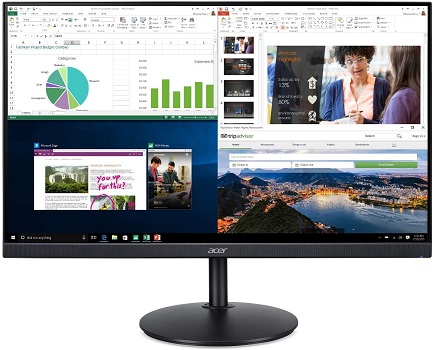
 VESA compatible
VESA compatible AMD FreeSync technology
AMD FreeSync technology Ergonomic
Ergonomic Decent response time and refresh rate
Decent response time and refresh rate
 No DisplayPort
No DisplayPort Few connectivity and customization features
Few connectivity and customization features
The reason we recommend this vertical monitor to you:
Since this device doesn’t market itself as a gaming monitor and as it’s rather affordable, it has a surprisingly fast response time and overall abilities. It has a low input lag, a wide viewing angle, great colors, and a very ergonomic round stand that takes up less space than a traditional rectangular stand. All of these characteristics make it a great device.
What to Consider When Choosing the Best Vertical Monitor: Buyer’s Guide
Display Type
First of all, you have to consider the different display types. There are:
- IPS (In-Plane Switching) monitors – great for photography and graphic work due to accurate colors
- LED (Light Emitting Diode) monitors – over-all quality and power-saving ability
- LCD (Liquid Crystal Display) – good performance at a low price
- Touchscreen – great for multipurpose use
Decent screen size
Depending on what you are planning to use the monitor for, make sure to choose a suitable screen size. If you are planning to use the screen for emails and sharing photos, you can buy a screen under 20 inches. For gaming and watching TV, it’s better to purchase a 21 to 26-inch display. For professional photography, graphic work, and gaming make sure to invest in a 27 or more inch screen.
Good resolution
There are HD and HD+ screens, Quad HD (QHD) screens, and 4K Ultra HD. The first type is the most affordable one, while the last type offers the best resolution and finest detailing.
Response times
Response time is the time it takes a computer screen to change colors. Having a quick response time (5 milliseconds or less) is especially important for gamer.
Touch screen
If you are used to working spending lots of time on your phone or another touch screen device and if want your computer to be more like a tablet, having a touch screen can be a nice addition.
Framerate
Framerate is the number of times the image refreshes in a second. Professional gamers may benefit from a framerate of around 240 Hz, otherwise, a 60 Hz framerate is more than enough.
Panel
- TN (Twisted Nematic) display panels are the most common ones. They are standard for LCD displays and tend to be rather inexpensive. They are known for great response times but tend to have lower-quality image.
- IPS (In-Plane Switching) panels offer rich colors, deep blacks, and over-all great image quality, but have the tendency to have a slower response time.
- MVA (Multidomain Vertical Alignment) display panels offer great contrast, an average image quality, and the slowest response time of the three types of panels.
Ergonomics
- Viewing Angle. Depending on the viewing angle, some panels present different images. A wider viewing angle may result in a distorted or blurred image with inaccurate colors. Manufacturers are striving to provide broader viewing angles and nowadays they are already able to provide a 178-degree viewing angle.
- Eye protection. Looking at all kinds of screens and digital displays for hours each day is unnatural and may lead to ocular muscle strain or other vision-related issues. Therefore, an increasing number of manufacturers are including a sort of eye protection features, like the ‘eye saver mode’ that reduces the harmful blue light emissions and flicker-free technology.
- As monitors should be positioned a precise distance and height from you, the ability to tilt or rotate the monitor may be a valuable feature.
FAQ
Can All Monitors Be Vertical?
Most monitors either have a default horizontal configuration or a default vertical configuration. However, you can also make horizontal monitors vertical (or vice-versa) by using a stand with a rotating head, which can change the position of the monitor.
How do I turn my monitor vertically?
Changing the monitor orientation tends to be simple. Usually, you must right-click on the screen and select the ‘show desktop’ option. Afterward, click on the orientation option and select your preferred orientation mode.
Are Vertical Monitors Good For Multiple-Screen Setups?
Vertical monitors are just as suitable for multiple-screen setups as horizontal ones. It simply depends on the programs you are using as some benefit from a vertical view and others benefit from a horizontal view.
Are websites better to view vertically?
It depends on the website. If there is a lot of text, graphics, or vertical photos, it is definitely better to select a vertical view.
Why do so many programmers use vertical monitors?
Programmers work with a lot of text, such as codes, configuration files, and documentation, which are usually organized in narrow columns. Therefore, vertical monitors match the shape better than horizontal monitors.
What resolution do I need for gaming?
The best resolution for gaming is 1080p and 1440p. 1080p is the most popular configuration. 1440p and 4K are becoming increasingly popular but often require the best graphics card options.
Do I need overdrive or motion blur reduction?
Too much overdrive can result in inverse ghosting or pixel overshoot, so don’t use it unless you experience excessive motion blur in fast-paced games. With higher refresh rate displays, overdrive is necessary for the optimal gaming experience.
What bit depth do I need?
You need at least 8-bit, preferably more (10-bit, 12-bit, 14-bit, 16-bit, or even 24-bit).

